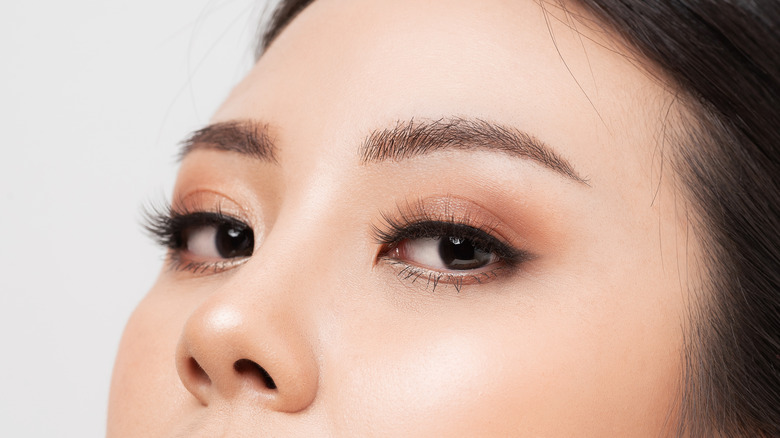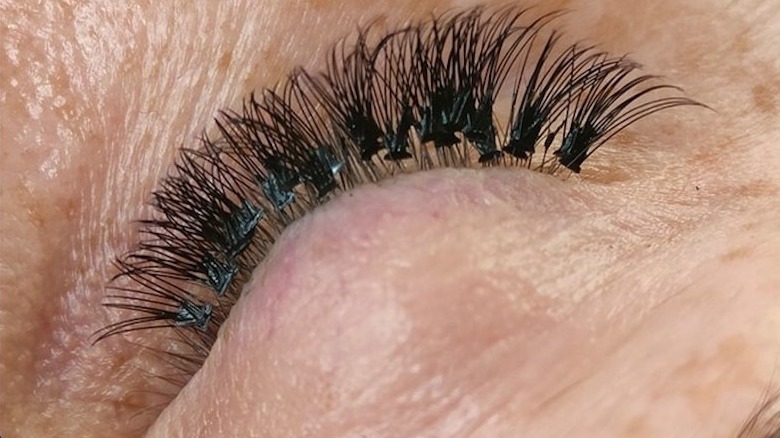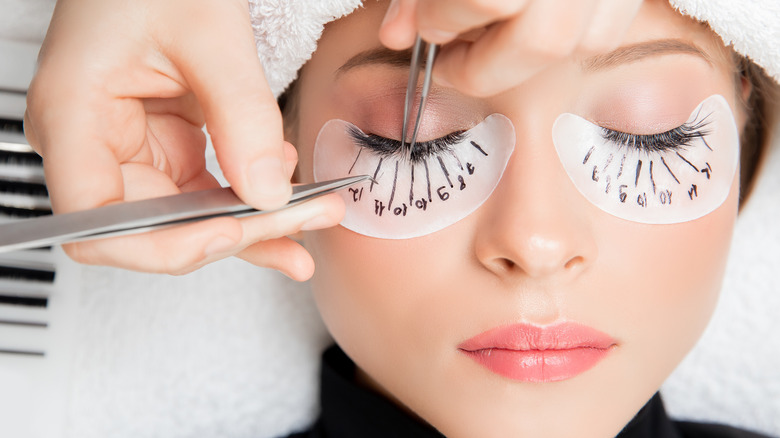Cluster Lash Extensions Vs. Individual Lash Extensions: What's The Difference?
Following in the footsteps of celebrities like Kim Kardashian, Beyoncé, and Katy Perry, people all over the world are incorporating semi-permanent eyelash extensions into their regular beauty routines. Long and luscious lashes may seem like the latest trend, but Marie Claire notes that styled and darkened lashes actually date back to Ancient Egypt. Several cultures adopted and adapted this beauty phenomenon throughout world history, until semi-permanent extensions, as we know them today, were born in South Korea in the 20th century (via Lash Lovers).
Modern lash extensions are lashes that are applied directly onto natural lashes with a semi-permanent adhesive by a professional and qualified technician. They're made from three different materials: mink, silk, and synthetic. While the latter gives a bolder look, mink and silk lashes tend to look the most natural (note that mink lashes aren't appropriate for vegans or those with allergies to cats). Within these categories, the lashes are either applied in larger groups, known as clusters; smaller groups, known as fans; or individually. Fans are included in the individual lash extension category, while cluster extensions are considered to be in their own lane by technicians — and have attracted some controversy over the years. There are benefits to both types of lash extensions, but beauticians across the board have a clear favorite.
What are cluster lashes?
Cluster lash extensions are a group of individual lashes that are assembled together. According to London Lash Pro, they are often taken from a larger strip lash and made into smaller sections, applied with glue at one end, and then finished with a thick base. For several reasons, experts don't recommend cluster lash extensions. Primarily, they don't shed naturally with human lashes, which can lead to infection. The application of cluster lashes can block the hair follicles, too, preventing the growth of new lashes and resulting in ingrown hairs. Cluster lashes are also an unhealthy option, Eslashes explains, because they weigh down the natural lash, in addition to sometimes pulling the natural lashes out when they fall out. Frequent wearing of cluster lash extensions can even result in permanent eyelash loss.
Despite these pitfalls, people tend to opt for cluster lashes anyway if they're looking for inexpensive or convenient extensions (via The Lash Professional). Generally, cluster lashes are applied in a fraction of the time that individual extensions take and cost a fragment of the price. If you're going to wear cluster lashes, beauticians recommend not wearing them for more than a day and never sleeping in them as the effect is similar to gluing an entire strip lash to your eyelid. Often, the adhesive touches the skin, which it's not designed to do, and this can trigger an immune response resulting in a lifetime allergy to lash extension adhesive.
Why do technicians prefer individual lash extensions?
A healthier alternative to cluster lash extensions, individual lash extensions come in singular lashes or a small number of lashes joined together in fans. They result in a more natural lash look than what is achieved through cluster lashes and are applied carefully in layers, with tweezers used to isolate the lashes. Individual lash extensions allow for customizations in the way of various lengths, curls, and thicknesses, as not all lashes will suit every eye and face shape. As EBL Lashes highlights, individual lash extensions are applied by a professional, while cluster extensions are typically sold at drugstores and don't require training or expertise. The price is higher, varying between salons but usually sitting somewhere between $150 and $300 for a first application. Additionally, individual lash extensions require more investment of time, with appointments taking up to two hours a pop.
Byrdie reports that around 80 to 140 individual lash extensions are required per eye, and technicians are careful to only use the adhesive on the natural lashes without applying it to the skin. While there is still the risk of lash damage with individual extensions, too, the risk is greater with cluster lashes due to their weight and application process, which doesn't allow for the precision required to avoid skin-to-adhesive contact. Despite the convenience and cost-effective nature of cluster lashes, lash technicians are unified in their stance: individual lashes are the much safer option.


